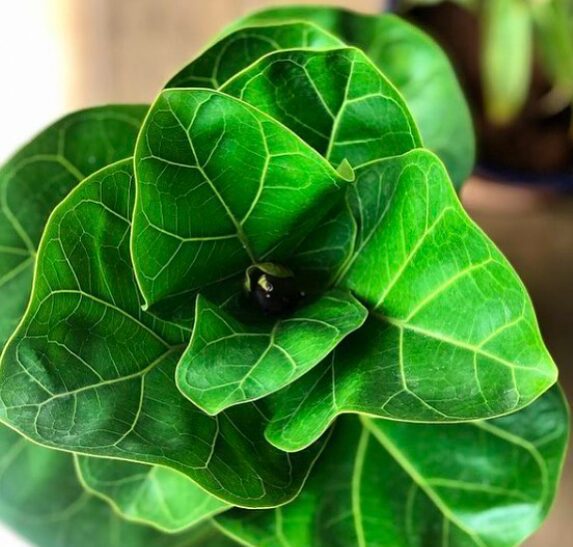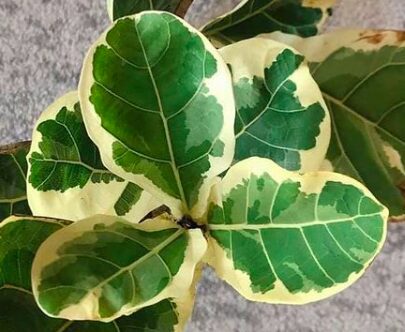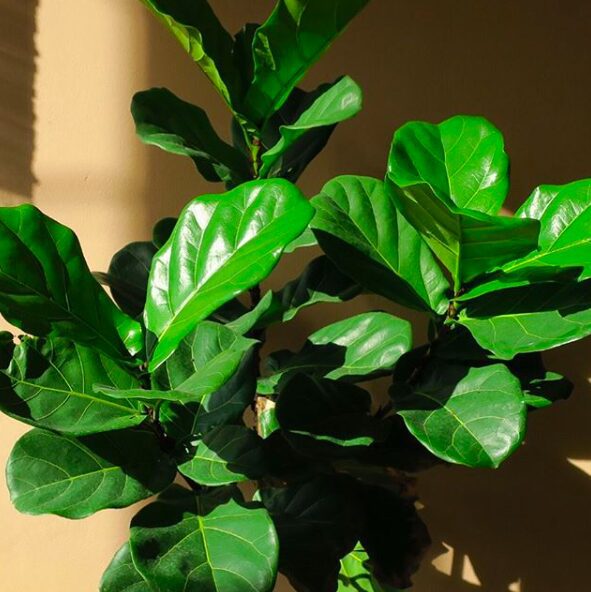Ficus lyrata, also known as the fiddle leaf fig or the banjo fig, is one of the most sought-after and beautiful (in our opinion) indoor trees and houseplants out there. With its stunning, fiddle-shaped leaves and whimsical lollipop shape, this tree adds a fun, spunky mood to any space. Though these plants have a reputation for being fussy, ficus lyrata care is actually very doable once you understand what makes these gorgeous trees happy.
Ficus lyrata is native to the tropical regions of West Africa. As a member of the mulberry family, or Moraceae, this tree can produce small, round fruits, though it rarely does so indoors. This tree is mostly grown as an indoor ornamental, but it can thrive outdoors in zones 9-11. Indoors, ficus lyrata can grow up to 10 feet tall, or even larger if the ceilings are high enough!
If you’d like to add ficus lyrata to your houseplant collection, here’s what you need to know!

Ficus Lyrata Care for Complete Beginners: What You Need to Know
How to Care for Ficus Lyrata
The most important thing to remember when it comes to fiddle leaf fig care is that you’re dealing with a tropical plant, so your fiddle will be happiest if you recreate its native conditions as much as possible. This means bright, warm, damp but not soaked soil, and decent humidity.
It’s not as complicated as it sounds! Let’s break all that down.
Watering
This tree likes evenly damp soil but will quickly develop root rot if you overwater.
Water when the top 2-3 inches of soil feel dry or when a moisture meter reads 3-4.
You might be just fine using the finger-poke method to test the soil, but we find that a moisture meter will give you a much better idea of what’s going on in the root ball, since it’s possible for the top few inches to feel dry even if the root ball’s completely soaked. (Here’s the moisture meter we recommend.)
A good rule of thumb is to water every 7-10 days, but we strongly suggest checking your plant’s soil every day to see if it’s ready for a drink and monitor for problems.
When you do water, you can use the cup method (recommended if you are a habitual overwaterer or if your plant doesn’t get a lot of light) or soak the soil and let it drain completely. Either way, make sure to empty the drainage tray immediately so your plant is never sitting in water.
If you’re still unsure how much to water, err on the light side. It’s much easier to fix slight dryness than overwatering or root rot!
Light
These plants love light! Choose a spot in an east-facing window or near a south- or west-facing window where your tree will get lots of bright, indirect sunlight.
These trees can tolerate and even thrive in full sun, but only if they’re fully acclimated to it. (Here’s how to do that.) Otherwise, keep your ficus lyrata out of direct sunlight to avoid leaf scorch.
If you aren’t able to provide enough sunlight, consider supplementing with a grow light.
Temperature
Ficus lyrata will thrive in typical room temperatures, which range anywhere between 65 and 80 degrees Fahrenheit. Be sure to keep your plant away from drafts, fireplaces, space heaters, and heating/AC vents to avoid freezing, burning, or drying out the leaves.
Keep this in mind when the seasons change and you turn on the heat or AC as the temperatures shift!
Soil & pH
Again, nothing will kill your tree faster than overwatering, which means your soil needs to drain quickly. Ideally, your fiddle leaf fig soil will balance drainage/aeration, water retention (because drying out too quickly isn’t good either), nutrition, and proper pH.
Choose a well-aerated, fast-draining soil for your ficus lyrata like cactus mix with some perlite mixed in or our Premium Fiddle Leaf Fig Potting Soil. Your tree will be happiest in a pH of 6 or higher. The moisture meter we recommended earlier also measures pH, so that may be a good investment if you’re concerned about maintaining the correct levels.
Fertilizing
A healthy, growing ficus lyrata will use up all the nutrients in its pot in a matter of months, so you’ll want to keep it nourished with a gentle, well-balanced liquid fertilizer.
Our favorite is Fiddle Leaf Fig Food, which we designed specifically for fiddle leaf figs to support the growth of big, beautiful leaves, a sturdy trunk, and a healthy root system.
Fiddle Leaf Fig Food is also gentle enough to use with each watering, so you won’t have to remember a fertilization schedule. Bonus!
You can buy Fiddle Leaf Fig Food on Amazon.
Pots & Repotting
Choose a pot with drainage holes that’s about 2-3 inches larger than your ficus lyrata’s root ball. That will give it room to grow without holding on to more water than the plant can use.
Drainage is essential here, but a lot of prospective plant parents balk at this because there are so many decorative pots out there that don’t have drainage holes. It’s tempting to buy one of these, plant your ficus in it, and cross your fingers, but your plant won’t survive for long. Don’t waste your time.
If you fall in love with a gorgeous planter without drainage holes, you have two options: drill some holes in the bottom (this can work with plastic, but you might have issues drilling through ceramic!), or you can try double-potting.
To do this, plant your ficus in a cheap plastic grower’s pot with drainage holes and put the whole thing inside your decorative planter or basket. Voilà! A beautiful planter for your beautiful plant. Just remove the plant when it’s watering time and let it drain completely before replacing it in the decorative planter.
Most fiddles will need to be repotted every year or two. If you notice roots popping out of the top of the soil or bottom of the pot, roots growing in a circle around the inside of the pot, compacted soil, or stunted growth, you may need to repot sooner.
Here’s how to repot a fiddle leaf fig!
Hardiness
Ficus lyrata is hardy outdoors in zone 9-11. If you live in a tropical climate and want to give this a try, go for it! These trees will grow up to 60 feet tall outside and look absolutely stunning when allowed to grow into their full majesty.
Common Issues
If your ficus lyrata is unhappy, the first place you’ll notice issues is the leaves. Here are the most common signs to watch for and what to do about them.
Dark-brown spots on lower leaves
This means your ficus is overwatered and has possibly developed root rot. If there are only a few spots, try scaling back on the water and using our Root Supplement when you do water to help the roots heal and protect from further infection.
Make sure to provide more light as well, because overwatering is often exacerbated, and sometimes caused, by insufficient light.
This is also a good time to check your drainage. If your soil is compacted or if the pot isn’t draining properly, it’s time to repot!
Root rot
If those dark-brown spots spread, your tree probably has root rot, so act fast! Repot the tree into fresh, fast-draining soil and a clean pot. If you notice any dark, mushy, or smelly roots, prune those off. After repotting, place the tree in a bright place and let the soil dry out a little more before watering. Use our Root Supplement and remove any affected leaves.
Medium-brown spots all over the tree
If you notice medium-brown spots that appear randomly on the plant, your tree might have a bacterial infection. Remove all affected leaves immediately (make sure to use clean hands and sterilized tools to prevent spreading bacteria) and follow the same instructions you would for root rot.
Yellowing leaves
This usually means that your tree is slightly overwated, needs more sunlight, or needs fertilizer. Check the lighting conditions and the moisture level of your soil, and if neither of those seem to be the problem, it’s probably time to fertilize. Learn more about treating yellowing leaves here.
Drooping or dropping lower leaves
This might be normal, healthy leaf drop. Learn more about that here.
Insects
Fiddles are vulnerable to pests like mealybugs, scale, spider mites, and fungus gnats. Read our guide on treating insect infestations here.
Dropping leaves
This can have many causes, from improper temperatures to insufficient light to incorrect watering. Read this article to narrow down potential causes and save your tree!
Ficus Lyrata Varieties
Ficus lyrata comes in a few different varieties, from the adorable and compact bambino to the striking and difficult-to-come-by variegata. Pick your favorite!

Ficus Lyrata “Bambino”
This is a popular dwarf variety that will only grow to 3-4 feet tall and remain quite bushy instead of tree-like.
Overall, it looks like a mini fiddle leaf fig, though the leaves tend to be slightly smaller, rounder, and thicker than those of the typical ficus lyrata. Keep in mind that these plants are often mislabeled in garden centers and may be sold as regular fiddles, much to the owner’s chagrin if they were looking forward to growing a big beautiful tree!
More rarely, a regular fiddle may be sold as a bambino. Be sure to examine the leaves, and if there are other fiddles in the same garden center, try comparing them to determine whether you’re buying a full-size fiddle or a bambino. It’s the perfect choice if you don’t have room for a tree in your home or if you’re nervous about caring for a fiddle and want to start with something a little smaller.
Care for a bambino is essentially the same as for a regular fiddle, so you can follow the care instructions in this article to keep your bambino healthy and beautiful!

Ficus Lyrata “Compacta”
This newer cultivar of ficus lyrata is similar to a bambino in that it’s a smaller version of ficus lyrata, but compacta tops out at 5 feet while bambinos will stay around 3 feet tall. The leaves are slightly smaller than that of a regular fiddle, but care is the same.
These cultivars are frequently mislabeled in stores and it’s tricky to tell the difference when they’re small, but you may have better luck locating a true compacta online from a reputable seller or grower.

Ficus Lyrata “Variegata”
Meet the variegated fiddle leaf fig, the Holy Grail for so many ficus lyrata fans!
You can recognize this cultivar by the stunning blocks of dark and light green, white, and cream on the leaves.
These trees are difficult to come by and nearly always must be ordered from the lab in Thailand that grows this cultivar. At the time of this writing, there are no growers in the U.S., but you may be able to locate a cutting from a private buyer on eBay, Etsy, or Facebook Marketplace.
If you do manage to get ahold of one, care is mostly the same as for regular fiddles, but be warned: since the leaves of ficus lyrata “variegata” contain less chlorophyll, these trees may have more difficulty photosynthesizing than regular fiddles. Providing more bright, indirect sunlight can help, but the lack of chlorophyll also makes these leaves more photosensitive, aka susceptible to sunburn. There’s a reason these trees were created in a lab and not found in the wild!
If you’ve had a lot of practice with fiddles and know what you’re doing, you may be up for the challenge of finding and caring for a variegated fiddle. If so, we’re rooting for you! (No pun intended.)
We’ve Got Everything You Need!
No matter what type of ficus lyrata you want to grow or how experienced you are with houseplants, Fiddle Leaf Resource Center has all the information and supplies you need to grow the healthiest and most beautiful ficus lyrata around.
Check out these resources to learn more!




